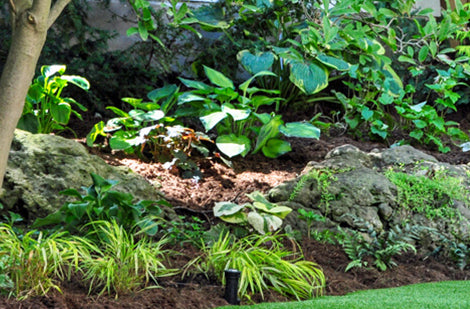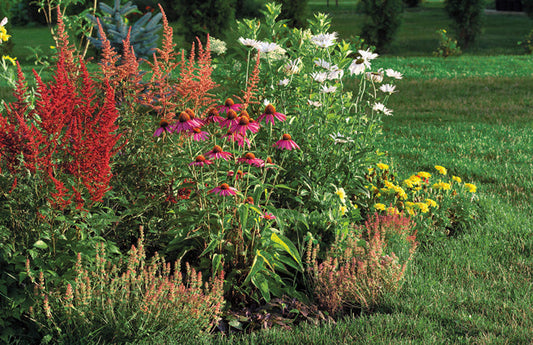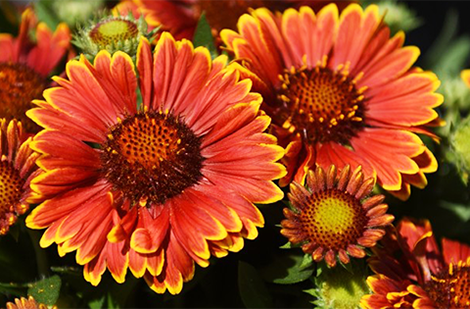Dianthus x hybrida 'Mad Magenta'
Dianthus x hybrida 'Mad Magenta' - 'Mad Magenta' Pinks
Dianthus x hybrida 'Mad Magenta' - 'Mad Magenta' Pinks
Exposure
- Sun
- Partial shade
Rusticity
Bloom time
- April
- May
- June
- July
- August
- September
- October
- Vibrant, fragrant hot pink blooms
- Largest single flowers
- Extended bloom time
- Ultra-tough (heat, humidity)
- Great for rock gardens
Be charmed by the vibrant display of 'Mad Magenta' Pinks (Dianthus x hybrida 'Mad Magenta')! This unique perennial will smother you with its stunning, fragrant, hot pink frilly flowers, boasting the largest single magenta pink blooms on the market. Very easy to grow and ultra-tough, it's an ideal choice for sunny mass plantings or rock gardens, promising an explosion of vibrant colour from spring to fall, even in the warmest regions.
Characteristics
- Foliage: Narrow leaves, grayish green in colour with hints of silvery blue. Forms a clump of grassy foliage and remains green throughout the year. Foliage is evergreen.
- Flowering: Is smothered in stunning, fragrant hot pink frilly flowers at the ends of the stems. Produces an abundance of large pink, deliciously sweet flowers. Blooming starts in early spring and continues sporadically until late fall, covering the plant with flowers from late spring to late summer. Flowers are excellent for cutting.
- Light Requirements: Prefers full sun to part shade. Full sun is optimal for abundant flowering.
- Habit: Compact, mounding habit. Forms a clump.
- Growth: Moderate grower. Reaches 15 to 20 cm (6 to 8 inches) tall and 15 to 20 cm (6 to 8 inches) wide, and continues to spread by underground shoots.
- Humidity: Little water needed once established. Prefers a soil consistently moist but not waterlogged initially. Possesses excellent heat and humidity tolerance.
- Soil: Requires good drainage. Excellent choice for hot dry sites or gravelly soils.
- Temperature: Very hardy. Possesses excellent heat and humidity tolerance even in the warmest regions.
- Watering: Water deeply 2 to 3 times per week for the first few weeks. Once established, it requires little water. Ensure the soil is consistently moist but not waterlogged.
- Resistances: Very tough. Possesses excellent heat and humidity tolerance. Ideal for hot dry sites.
Usage
- Types of Use: Excellent for mass plantings for sunny, hot areas, rock gardens, and as a border edging. Combines beautifully with other low alpine plants. Flowers are excellent for cutting. Attractive to butterflies.
- Decorative Benefits: Its intense magenta colour and profusion of frilly flowers create a striking visual impact. Its evergreen grayish-green foliage provides an attractive contrast and year-round interest.
Maintenance
- Fertilization: Generally little to no fertilization is necessary in average soil. A spring compost application may be sufficient.
- Pruning: Shear plants back lightly after blooming to maintain a tight, compact habit. Deadhead old flowers to promote continuous blooming.
- Plantation:
- Spacing: Approximately 30 to 35 cm (12 to 14 inches) apart to allow for good development.
- Depth: Plant at the same depth as it was in its container.
- Period: Spring is the ideal time for planting. Blooms the first year.
Plant details
Dimensions
Dimensions
Characteristics
Characteristics
Habit:
- Compact
- Mounding
Flowering colours:
- Pink
- Magenta
Plant needs
Plant needs
Watering:
- Tolerates dry, well-drained soil
Maintenance:
- Easy
- Deadhead (spent flowers)
Soil requirement:
Features
Features
Resistance:
- Heat
- Cold
- Drought
- White-tailed Deer
Attract:
- Butterflies
Use:
- Border
- Mass Planting
- Flowerbed
- Rock gardens
Attribute:
- Long Blooming
- Cut Flower
- Moderate Growth
- Fragrant
- Hardy

Related articles
-

Perennials for all occasions
Read the articleOsez créer des associations inédites qui sauront refléter votre personnalité, même si pour cela vous deviez déplacer certaines vivaces pour mieux les mettre en valeur.
-

Landscaping with perennials
Read the articleVariétés à découvrir, la tomate se savoure crue, en sandwich, en bruschetta ou en salade. Cuite, c'est l'ingrédient de base de sauces, soupes et salsas.
-

Perennials proper maintenance: cut and fertilize
Read the articleLa grande popularité des vivaces vient du fait qu'après avoir été oubliées pendant des mois au cours de l'hiver, elles réapparaissent sur la scène plus énergiques et surprenantes que par...
-

How to plant perennials in your garden
Read the articleEn pénétrant au jardin, ce sont souvent les plantes vivaces que l’on remarque en premier. Un massif de sauges, d’hémérocalles, d’astilbes, d’échinacées ou de lavande offre un spectacle d’une beauté...









